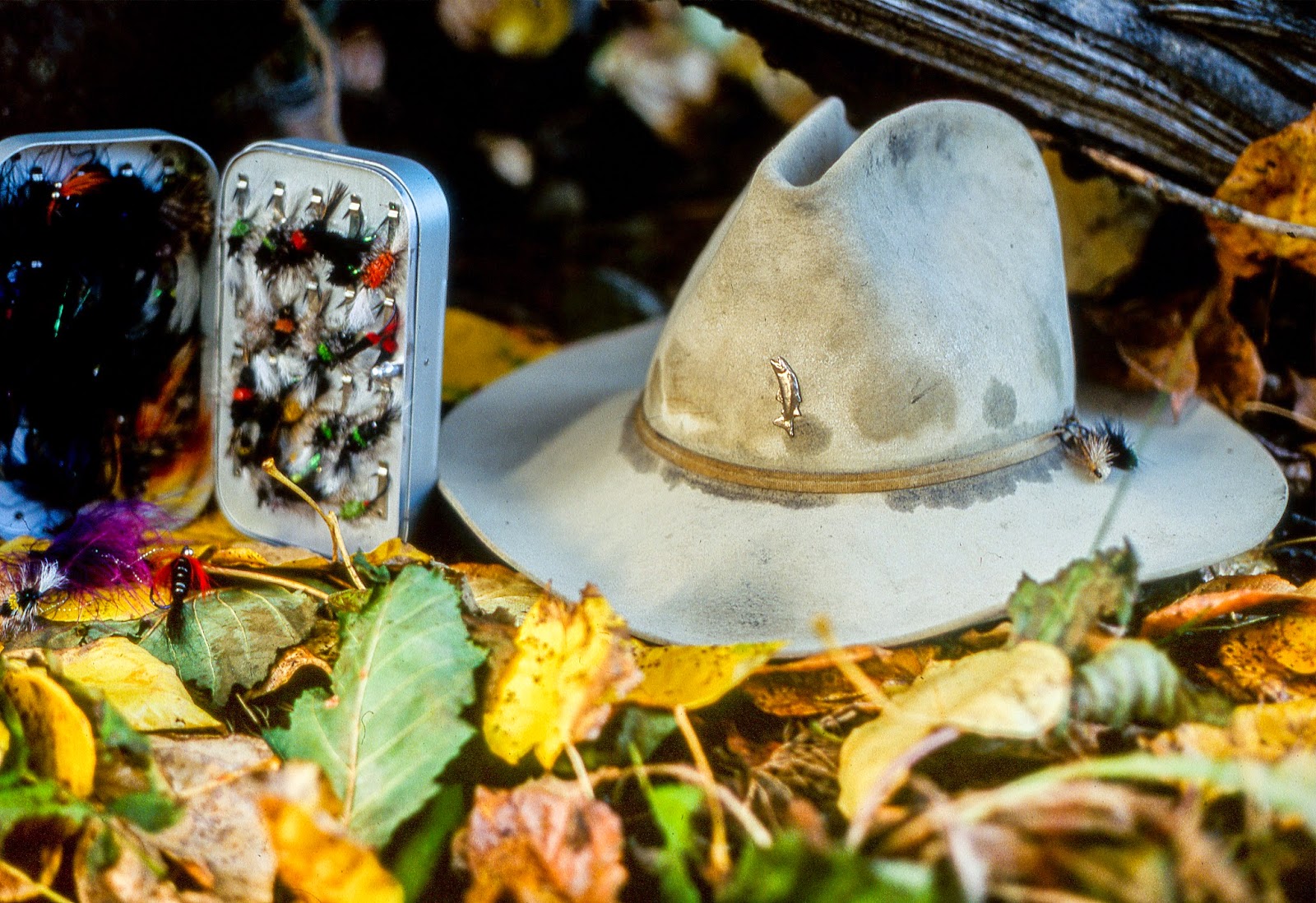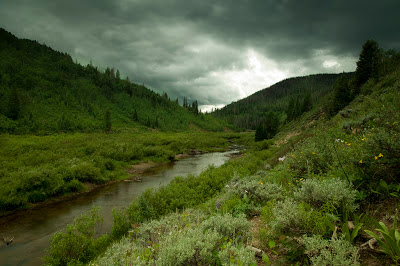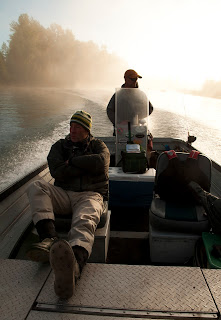The
other day I got a call from Jim Vincent; one of this industries more innovative
personalities, a great stick regardless of species, and at one time a prolific
writer. Fortuitously I had him queued up
for my next Throwback article after I came across this photo I took of him
bowing while fast to a pissed off tarpon.
For those not familiar with who he is, Jim and his wife Kitty began RIO,
a leader, tippet and fly line company that changed all aspects of terminal
tackle as we know them today. He sold
the company a decade ago, yet he still helps them pursue perfection when it
comes to the products that RIO offers.
That is, however
when he's not fishing or chasing upland game, which he does a fair amount of now that he's retired.
when he's not fishing or chasing upland game, which he does a fair amount of now that he's retired.
 In 1990
or 91 I met Jim and Kitty at a buyers show in Denver. They had some cleaver little gadgets, some
waterproof journals and a few other nick
knacks in their 10' X 10' booth , but nothing in particular that would lead one
to believe that they would one day turn the fly line industry on it's
head. Jim and I hit it off . Our common ground for chasing steelhead and
fishing the Henry's Fork has led to a long relationship, yet it was the
steelhead game that created that first ah ha moment with he and Kitty's new
found company.
In 1990
or 91 I met Jim and Kitty at a buyers show in Denver. They had some cleaver little gadgets, some
waterproof journals and a few other nick
knacks in their 10' X 10' booth , but nothing in particular that would lead one
to believe that they would one day turn the fly line industry on it's
head. Jim and I hit it off . Our common ground for chasing steelhead and
fishing the Henry's Fork has led to a long relationship, yet it was the
steelhead game that created that first ah ha moment with he and Kitty's new
found company.
When I
began the steelhead game I quickly learned that the only leader and tippet
material you used was Maxima. For those
who pursued these fish there were simply no other viable choices. I learned that the hard way, but that's
another story. Although it was a tough
material, their system for keeping it on the spool was useless and a constant
source of frustration. It was always a
tangled mess and in various stages of unwind in your vest. That was until Jim came up with Tippet
Tamers.
Most of
you probably have never heard of this product, but at the time the two rubber
sowing machine belts that came in each package of Tippet Tamers when fit
securely around a spool of Maxima solved this chronic problem. Next to meeting these two charismatic people
from RIO, of all the cool stuff I saw at that show, there was nothing I was more exited about
than those.
It
wasn't too long after we met that I started to learn how to use a Spey rod.
Unlike today where one has a variety of ways to quickly queue up a Spey casting lesson, I
learned from a set of simple stick figure drawings that Jim sent me. Like most
things fly-fishing he was always out front of the game and at the time he was
the only person I knew who had taken up the big rod. It wasn't the easiest way to learn, but
between my frequent phone conversation with Jim, what books I could find on the
subject, and an eventual lesson from him that I started to figure it out. I'm sure I drove him nuts.
Jim's
dedication towards manufacturing the
best fly lines, leaders and tippets became evident when he invited me to join
him on one of his two week saltwater R & D sessions in Key West. Twice a year, Jim and members of his RIO
team would work with key dealers on improving the growing line of RIO
products. First in Key West, then with a
fall trip to the Missouri River. I knew
little of these trips, but by now I knew Jim pretty well and knew above all he
liked to fish. Although we did plenty
of that, the R & D part was far more extensive than what I had originally
surmised.
From the
moment I arrived in Key West my initial perception of what was going to go down
for my brief stay was throttled . There
was stuff everywhere in the living room of the house he'd rented, and by stuff
I mean boxes of fly lines, leaders, backing
and tippet. In a corner stood a pile of rods. Strewn
across the kitchen table and counter were an array of very nice saltwater reels
loaded with the latest fly lines to test.
Sitting off to the side was another pile of reels ready to receive the
next saltwater prototype. It was an
overwhelming and impressive sight , but what really impressed me was Jim
constant focus.
After
our day on the water Jim was still processing how the products we tested
performed. In the middle of dinner he
pulled out a small pad and pen and began to write down his impressions, some
calculations and thoughts we'd just discussed.
As much as he had been driven to become a very talented and diverse
flyfisher, it was evident as well that he was equally motivated to build a
successful fly-fishing company and the best products in the business. Over the years that pad and pen became a
familiar item I'd see Jim scribbling on.
Even in our most recent conversation he was still tweaking and refining
that which he set in motion over twenty years ago. He just can't let that inquisitive process
rest.
One of
my most memorable encounters with Jim involved my son, Mike. It was almost a
decade after we'd met. My son and I were
on the Henry's Fork when he was around 12 or 13 years old. Since the Henry's Fork was in Jim's back
yard, it wasn't unusual to find he or
Kitty chillin in their Airstream or fishing these fabled waters. We came across Jim and watched him proceed to hook a nice
rainbow. Nonchalantly with trout in tow,
he waded over to us casually handing my son the rod and briefly instructed him
on how to land this fish, which Mike eventually did. Mike at his young age didn't have any
experience with a fish like this, and I remember Jim telling him "if the fish wants to run, let him
run. If it stops reel it in". I
still crack up a little when ever I think about that moment knowing that as
easy as he made it sound, for those of us who fish this river we know this to
be far from true.
Although
those that know Jim recognize him for his business success, few knew him as a
gifted writer. It's a rare steelhead
season when I don't pull out one of his old articles in Gray's Sporting
Journal. What I liked about his writing,
other than he was a great story teller, is he never gave away his waters. There may be hints in his writings, but he
never promoted the rivers he
fished. With the advent of social
media, and selfies I'm sure Jim's aversion to todays frivolous practices leaves
him rolling his eyes rolls. If you like
good writing, and can procure any of his old articles, I would recommend doing
so, especially if you steelhead fish.
Although he hasn't written a piece in a while, now that he's got more
time, I wish he'd put pen to paper once again.
There
have been a number of people who have
come to know in this industry, some more influential then others. Jim was one of the later. Before we hung up, we got onto the subject of
steelheading. It's pretty rare that we
don't. That's one thing we have never
done together. Given his contributions
to my steeheading prowess, while I still can I hope that's something we'll be
able to do that, especially while we
still have t time.

.jpg)
.jpg)




.jpg)
.jpg)
.jpg)
.jpg)
.jpg)
.jpg)
.jpg)